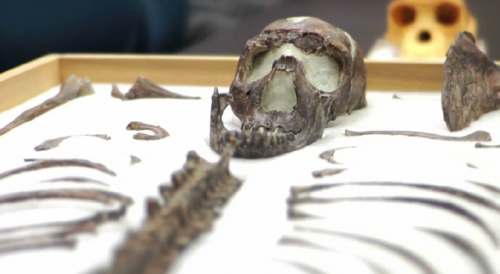What is the fastest articulated motion a human can execute?

(Phys.org) —Humans are amazing throwers. We are unique among all animals, including our closest living relative, the chimpanzee, in our ability to throw projectiles at high speeds and with incredible accuracy. This trait was critical to the survival and success of our ancestors, aiding their hunting and protective skills, according to National Science Foundation- (NSF) funded research featured on the cover of this week's journal Nature.
Harvard University researchers supported by NSF's Biological Anthropology Program discovered that humans are able to throw projectiles at incredible speeds by storing and releasing energy in the tendons and ligaments crossing the shoulder. This energy is used to catapult the arm forward, creating the fastest motion the human body can produce and resulting in very rapid throws.
"Our research demonstrates that the ability to store energy in the shoulder is made possible by three critical changes in our upper bodies that occurred during human evolution," said Neil Roach, lead researcher currently at the Center for the Advanced Study of Hominid Paleobiology at The George Washington University. "The expansion of the waist, a lower positioning of the shoulders on the torso, and the twisting of the humerus (the bone in the upper arm) are the key morphological changes that first appeared together nearly two million years ago in the species Homo erectus."
Two million years ago is also the time at which the archaeological record suggests that our hominin ancestors began to hunt more intensely. "We think that throwing was probably most important early on in terms of hunting behavior, enabling our ancestors to effectively and safely kill big game," said Roach. "Eating more calorie-rich meat and fat would have allowed our ancestors to grow larger brains and bodies and expand into new regions of the world—-all of which helped make us who we are today."
To discover how and why humans throw so well, Roach and his team used a 3-D motion-capture camera system—similar to those used to make video games and animate movie characters—to record the throws of collegiate baseball players. They analyzed these data using simple physics that breaks down complex movements into the individual motions occurring at each joint and determined velocity and estimated the forces needed to create each motion.
The authors found that humans are able to throw with such velocity by storing elastic energy in their shoulders. This energy storage occurs in the "cocking" phase of the throw, when the arm is pulled backward away from the target.
"The cocking of the arm stretches the tendons, ligaments and muscles crossing the shoulder and stores elastic energy, like a slingshot," said Roach. "When this energy is then released, it powers the very rapid rotation of the upper arm, which is the fastest motion the human body produces. This rapid rotation also causes the elbow to quickly straighten and the projectile to be released at very high speeds."
The team also used therapeutic braces to limit the throwers' movements. "The braces allowed us to mimic our ancestral anatomy in modern throwers, giving us the opportunity to see how anatomical changes that occurred during our evolutionary past would have affected our ability to throw," said Roach.
Roach's study is the first to suggest a link between human's incredible throwing ability and the critical evolutionary shifts made possible by our ancestors' increased hunting. It is also the first to demonstrate the use of elastic energy in the human arm. Next, Roach and his colleagues plan to build on their work by determining what type of objects our ancestors actually threw.
Journal information: Nature
Provided by National Science Foundation


















